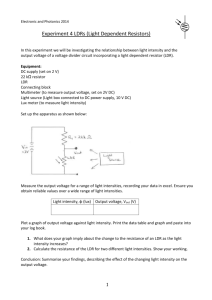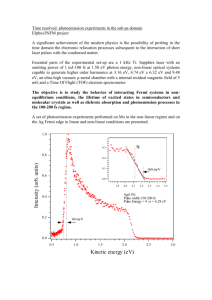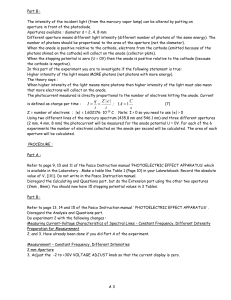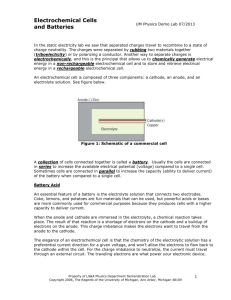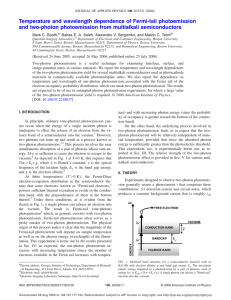Photoelectric Effect..
advertisement
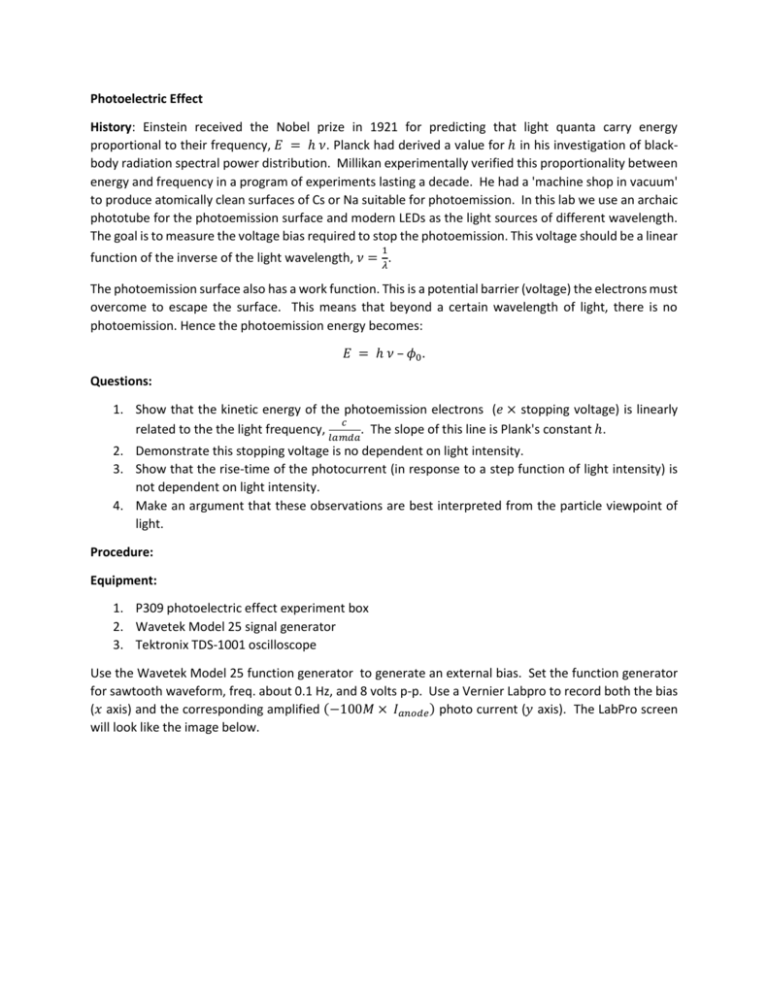
Photoelectric Effect History: Einstein received the Nobel prize in 1921 for predicting that light quanta carry energy proportional to their frequency, 𝐸 = ℎ 𝜈. Planck had derived a value for ℎ in his investigation of blackbody radiation spectral power distribution. Millikan experimentally verified this proportionality between energy and frequency in a program of experiments lasting a decade. He had a 'machine shop in vacuum' to produce atomically clean surfaces of Cs or Na suitable for photoemission. In this lab we use an archaic phototube for the photoemission surface and modern LEDs as the light sources of different wavelength. The goal is to measure the voltage bias required to stop the photoemission. This voltage should be a linear 1 function of the inverse of the light wavelength, 𝜈 = 𝜆. The photoemission surface also has a work function. This is a potential barrier (voltage) the electrons must overcome to escape the surface. This means that beyond a certain wavelength of light, there is no photoemission. Hence the photoemission energy becomes: 𝐸 = ℎ 𝜈 – 𝜙0 . Questions: 1. Show that the kinetic energy of the photoemission electrons (𝑒 × stopping voltage) is linearly 𝑐 related to the the light frequency, 𝑙𝑎𝑚𝑑𝑎. The slope of this line is Plank's constant ℎ. 2. Demonstrate this stopping voltage is no dependent on light intensity. 3. Show that the rise-time of the photocurrent (in response to a step function of light intensity) is not dependent on light intensity. 4. Make an argument that these observations are best interpreted from the particle viewpoint of light. Procedure: Equipment: 1. P309 photoelectric effect experiment box 2. Wavetek Model 25 signal generator 3. Tektronix TDS-1001 oscilloscope Use the Wavetek Model 25 function generator to generate an external bias. Set the function generator for sawtooth waveform, freq. about 0.1 Hz, and 8 volts p-p. Use a Vernier Labpro to record both the bias (𝑥 axis) and the corresponding amplified (−100𝑀 × 𝐼𝑎𝑛𝑜𝑑𝑒 ) photo current (𝑦 axis). The LabPro screen will look like the image below. Be sure to set the appropriate switches to "Ext. Bias" and "10V/uA". There are cables that go from BNC to the Vernier LabPro. To demonstrate that the stopping voltage is independent of light intensity, take three data sets with different LED intensities. Set the LED current to the maximum, and take I-V curves for each of the light colors. Then use each of the neutral density filters to lower the light intensity, and repeat the data set. The ND filters are Edmunds 76668, 40% transmission. Be sure to align the LED illumination so that the 1p39 tube anode (the wire in the center) is masked by the black tape. This requires a visual inspection each time a new LED color is selected with the front panel switch. The main issue in data analysis is systematically determining the zero point of the cathode current in the I-V curves. There is a background anode photocurrent; it is best to minimize this by masking the anode illumination. Likewise it is important to use the cover to eliminate background light. Using your favorite software tool (Excel, matlab, labpro, ...) to to fit the I-V data sets and derive the 'takeoff' value (stopping voltage) for each wavelength. To demonstrate that the photocurrent rise time is independent of light intensity, use the external drive mode for the 464 nm LED and measure the cathode currently directly as the voltage across a 10kΩ resistor. Set the LED drive switch to "Ext. 464 nm" and the cathode current switch to "10 k". Set the bias switch to local, and set the bias voltage to zero in order to get the largest anode current, and of course align the 464 nm illumination. Use the Wavetek AUX OUT CMOS/TTL output for to directly drive the 464 nm LED. Tee this signal to the Ext Trig of the oscilloscope, which should be set to Ext Trig mode. The Wavetek frequency should be about 50 kHz. (Using an oscillator output with DC bias and bipolar waveform makes for funny LED behavior, and the current rise time reflects this.) Use the two neutral density filters to modulate the light intensity to 1.0, 0.4, and 0.16. The TDS-1001 oscilloscope can record a trace to a USB stick. Insert the USB stick and allow the TDS-1001 to recognize it. Press SAVE/RECALL and then the SAVE button. A time icon should appear; it takes about 30 sec to complete the save. Be sure to work with the Excel (ASCII) file to fit the rise time and amplitude. (There will also be an image file. Just use that one for reference.) From the amplitude of the voltage on the 10kΩ resistor, calculate the current. Estimate the illuminated area of the photocathode. Assume the light and photoemission process are a continuum (non-quantized) process, so in effect a patch of surface has to 'heat up' before emitting an electron. To provide current (electrons/sec) at a rate proportional to the inverse of the rise time, what area would this patch need to be? 𝐴 𝑒 × = 𝐼, 𝑎0 𝜏 where 𝜏 is the measured rise time, 𝐼 the photocurrent, 𝐴 is the total illuminated cathode area, and 𝑎0 is the unknown patch size where one electron is leaving the surface per time period 𝜏. Compare this to what you know about atomic dimensions. More significantly, this patch area would have to change with light intensity to keep the rise time constant. Now consider a picture where particles of light (photons) are randomly hitting the surface, and the surface, also randomly (with a quantum efficiency), is emitting electrons. This statistical model is able to more simply explain the constant rise time for any light intensity. We should add here that this experimental implementation is not a true measure of the photocurrent response time. A more elaborate arrangement could demonstrate that it is much faster than microseconds.
